
The long-billed hermit is a bird in the family Trochilidae, the hummingbirds. It is found from central Mexico south through Central America, Colombia and Ecuador into Peru.

The purple-throated woodstar is a species of hummingbird in tribe Mellisugini of subfamily Trochilinae, the "bee hummingbirds". It is found in Colombia, Ecuador, and Panama.

The amethyst woodstar is a species of hummingbird in tribe Mellisugini of subfamily Trochilinae, the "bee hummingbirds". It is found in every mainland South American country except Chile and Uruguay and has been recorded as a vagrant on Trinidad.
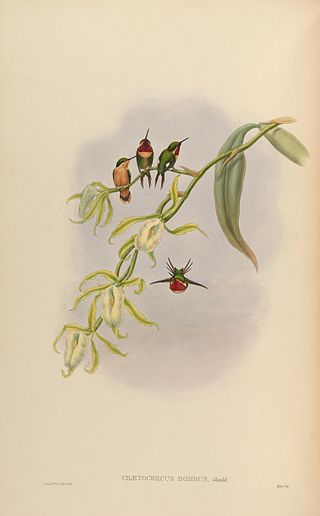
The little woodstar, called estrellita chica in South America, is a Near Threatened species of hummingbird in tribe Mellisugini of subfamily Trochilinae, the "bee hummingbirds". It is found in Colombia, Ecuador and Peru.

The gorgeted woodstar is a species of hummingbird in tribe Mellisugini of subfamily Trochilinae, the "bee hummingbirds". It is found in Colombia, Ecuador, and Venezuela.

The rainbow starfrontlet is a species of hummingbird in the "brilliants", tribe Heliantheini in subfamily Lesbiinae. It is found in Ecuador and Peru.
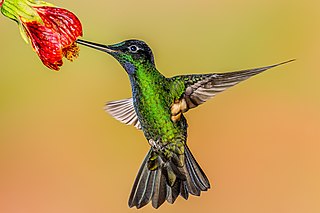
The buff-winged starfrontlet is a species of hummingbird in the "brilliants", tribe Heliantheini in subfamily Lesbiinae. It is found in Colombia, Ecuador, and Peru.

The emerald-bellied puffleg is a species of hummingbird in the "brilliants", tribe Heliantheini in the subfamily Lesbiinae. It is found in Colombia, Ecuador, and Peru.

The Chilean woodstar is a Critically Endangered species of hummingbird in tribe Mellisugini of subfamily Trochilinae, the "bee hummingbirds". It is the only species placed in the genus Eulidia. It is endemic to Chile though there are unconfirmed reports from southern Peru. The species' name commemorates the English naturalist William Yarrell.

The amethyst-throated sunangel is a species of hummingbird in the "coquettes", tribe Lesbiini of subfamily Lesbiinae. It is found in Bolivia, Ecuador, and Peru.

The black-throated brilliant is a species of hummingbird in tribe Heliantheini of subfamily Lesbiinae. It lives in Brazil, Colombia, Ecuador and Peru.
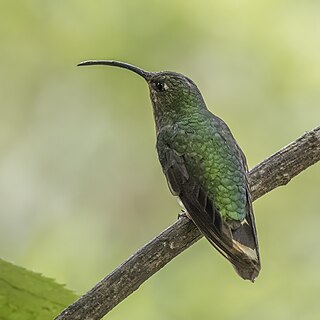
The mountain velvetbreast is a species of hummingbird in the "brilliants", tribe Heliantheini in subfamily Lesbiinae. It is found in Colombia, Ecuador, Peru, and Venezuela.

The neblina metaltail, locally called metalura neblina or colibrí de neblina, is a species of hummingbird in the "coquettes", tribe Lesbiini of subfamily Lesbiinae. It is found in Ecuador and Peru.

The viridian metaltail is a species of hummingbird in the "coquettes", tribe Lesbiini of subfamily Lesbiinae. It is found in Colombia and Ecuador.

The slender-tailed woodstar is a species of hummingbird in tribe Mellisugini of subfamily Trochilinae, the "bee hummingbirds". It is the only species placed in the genus Microstilbon. It is found in Argentina and Bolivia.
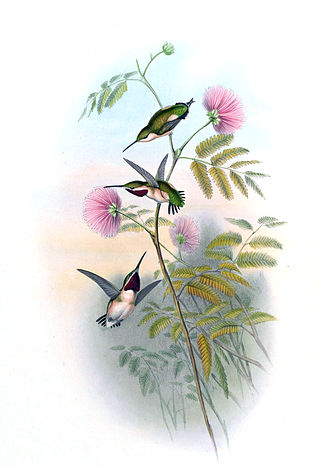
The short-tailed woodstar is a species of hummingbird in tribe Mellisugini of subfamily Trochilinae, the "bee hummingbirds". It is the only species placed in the genus Myrmia. It is found in Ecuador and Peru.

The great sapphirewing is a species of hummingbird in the "brilliants", tribe Heliantheini in subfamily Lesbiinae. It is found in Bolivia, Colombia, Ecuador, and Peru.

The purple-backed thornbill is a species of hummingbird in the "coquettes", tribe Lesbiini of subfamily Lesbiinae. It is found in Bolivia, Colombia, Ecuador, Peru, and Venezuela.

The Peruvian sheartail is a species of hummingbird in tribe Mellisugini of subfamily Trochilinae, the "bee hummingbirds". It is the only species placed in the genus Thaumastura. It is found in Chile, Ecuador, and Peru.
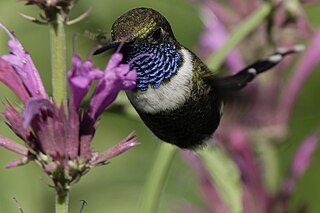
The sparkling-tailed woodstar, also known as the sparkling-tailed hummingbird, is a species of hummingbird in tribe Mellisugini of subfamily Trochilinae, the "bee hummingbirds". It is the only species placed in the genus Tilmatura. It is found in El Salvador, Guatemala, Honduras, Mexico, and Nicaragua.































